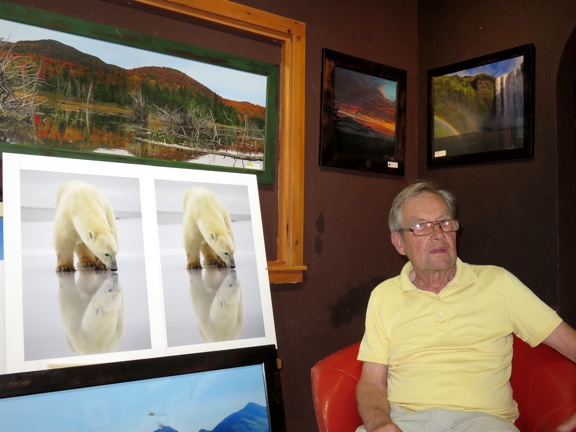ARTIST PROFILE: Rolf Schulte reflects on a lifetime of photography

Rolf Schulte poses with some of his photography. (Provided photo — Steve Lester)
LAKE PLACID – Rolf Schulte, 81, describes his younger self as a restless teenager who yearned to see the world while growing up in a village near Dusseldorf, Germany.
A five-year stint as a cook on various ocean liners and oil tankers prompted him to move to New York City from which he would take fishing trips to Lake Placid.
“I came here to fish one time in the fall, and I was hooked,” he said. “I told my wife, ‘We have to move there.'”
And move here they did in 1968.
In addition to the cooking aspect, Schulte worked hard to learn the ins and outs of the restaurant and motel business such as construction, plumbing, heating and air conditioning. But during this time, he never lost his passion for photography that he said began when he was 10 years old.
You can see how that passion developed at his 10-year-old gallery, “A Point of View” at 6047 Sentinel Road. Fellow photographer Carl Rubino, featured in the Lake Placid News on Jan. 19, 2017, described Schulte as “clearly one of the best scenic landscape photographers in the Adirondacks.”
Schulte’s 2013 publication, “Adirondack Panoramas,” demonstrates his deft touch with a shutter while capturing the reflective nature of remote lakes and rivers at all times of the day, the grandeur of the views from atop the High Peaks with Dix Mountain being his favorite, and the vibrant beauty of fields of wild flowers.
From an early age, Schulte used twin lens reflex cameras such as a Rolleiflex and a Leica M3 that are held at waist level as the photographer looks down into the viewfinder through a reflex mirror which allows for more steady holding compared to when the camera is raised up to eye level. In 2000, he bought a Noblex 6/150 FE panoramic camera that requires a tripod and two hands. If you plan to schlep it up the High Peaks, it may also require a couple of helping hands to manage its bulky weight that could exceed 50 pounds when combined with all the other equipment.
Once in place and ready to shoot, its user has to be very particular about what images he plans to capture because the camera holds only six negatives. If shooting from a mountaintop, it can often be too cold or just too difficult to change film.
A theme of serenity pervades throughout most of Schulte’s Adirondack photos largely because they hardly ever include any humans. One exception to this remains an area classic by the way it includes so many humans in such a relatively small area thrashing about in Mirror Lake at the start of the Ironman Lake Placid triathlon prior to its current orderly system of having small groups of swimmers enter the lake and hit the water swimming. Instead, the photo depicts the old way when a small group of elite athletes would take off first while everybody else, more than 2,000 in all, had to wade into the starting area in neck deep water, stand there practically shoulder to shoulder, and then try to take off all at once.
To describe that as “a competitive situation” might qualify one for having made “the understatement of the year.” With the rising sun in the background while a helicopter hovers in the distance, Schulte’s 2007 image can come close to making one feel as if being right in the middle of all that aquatic mayhem.
Schulte’s early life’s travels also took him to South America, western Canada and Alaska where he photographed indigenous natives in the 1950s and early 1960s.
Upon his arrival to Lake Placid in 1968, he quickly found a job cooking at the Edelweiss restaurant on Averyville Road owned by Gus Lussi, the legendary skating coach reported to have trained 23 world champions and six Olympic gold medalists to include Dick Button and Dorothy Hamill.
“He was really a good guy,” Schulte said with sincere fondness, and added that he let Schulte manage the business because his activities in the skating world didn’t allow him to learn all that was needed to operate a successful restaurant.
As an example, he related a time when he discovered the Swiss chef out enjoying a swim at 2 p.m.
“To run a restaurant right you have to be working, working, working, working all the time,” he said.
As much as he personally liked Lussi, Schulte worked for him for just that one summer, he said, before moving over to Howard Johnson’s after the owner there convinced him that such an off-the-beaten-path establishment would never survive the desolate winters compared to Howard Johnson’s, the current day ‘dack Shack on Saranac Avenue, the main thoroughfare into town from the west, across from the Lake Placid Center for the Arts.
Schulte’s commitments to such restaurant activities didn’t allow for much time to take photographs until 1985 when he would spend his increasing free time trekking off into the mountains. With the help of his daughter, Margarete, who manages the gallery, he has established a reputation for quality photos matched by few.
Rubino said that Margarete deserves considerable credit because she “does a fantastic job of processing and printing his work. She has a real eye for post processing in PhotoShop.”





